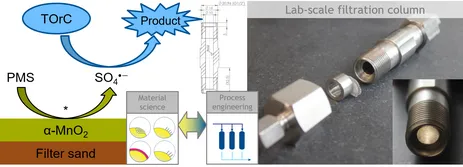- OrbiFragsNets. A tool for automatic annotation of orbitrap MS2 spectra using networks grade as selection criteria. MethodsX 11, 2023, 102257 more…
Water decontamination through sulfate-radical oxidation in a nano-enabled catalytic filtration process for non-potable and potable water reuse
The overall objective of the project is to develop an alternative process for trace organic chemicals (TOrCs) removal that is based on the in-situ generation of sulfate radicals in a simple depth filter. Conventionally treated wastewater cannot be reused before removing TOrCs and dangerous microbiological elements, which can affect human, animal, and plant health. Sulfate radicals have been discovered to be more selective than hydroxyl radicals and possess a higher oxidation potential in removing trace organic chemicals. Homo- and hetero-genous metal and non-metal catalysts have been found to create radicals through electron interaction with peroxymonosulfate. This project expands on a novel catalytic filtration method through the activation of peroxymonosulfate (PMS) via a Manganese (II) Oxide catalyst immobilized on granular activated carbon (GAC), which is used to remove TOrCs. The project encompasses the design, validation, optimization and scale-up of a flow-through column system for TOrCs removal.
The optimal conditions are first researched in a lab-scale setup with secondary wastewater effluent. This is, followed by a scale-up and installation in the Schweinfurt wastewater treatment plant to treat secondary wastewater as a comparable alternative to conventional treatment technologies. The last milestone consists of conducting a techno-economic analysis of this setup to determine its feasibility as a practical solution for the production of potable and nonpotable water.
Project leader | |
| Researcher | Mohammad Sheryraar Khan, M.Sc. |
| Funding | BMBF |
| Collaboration | Tel Aviv University, Xylem Water Solutions Herford GmbH |
